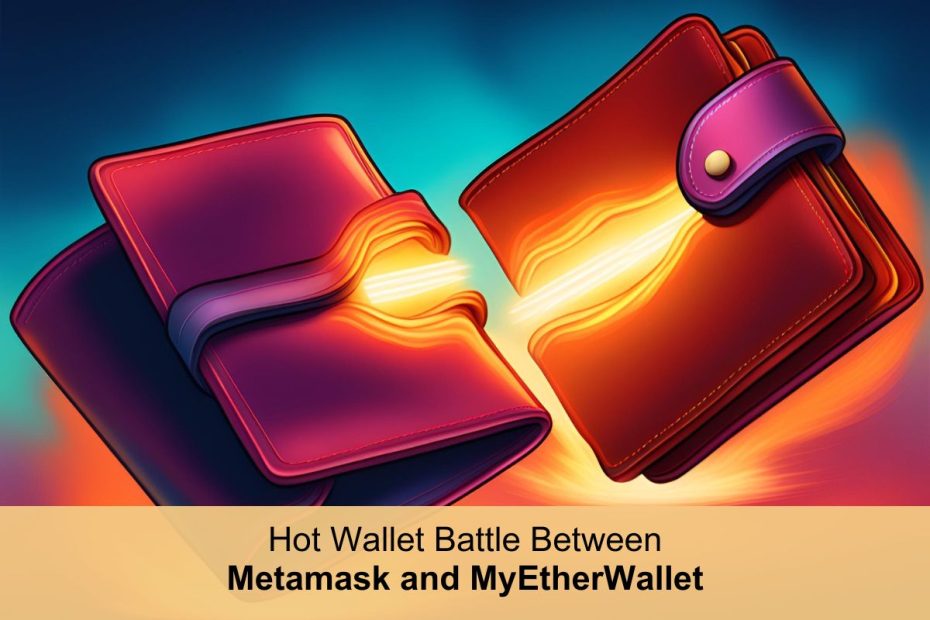The crypto wallet landscape is dominated by hot wallets. You only have to type crypto wallet in your search bar to glimpse the sheer number of options available. But what is your best option?
This series pits the best hot wallets against one another, offering close comparisons to help you decide for yourself. The first installment is a heavyweight battle featuring Metamask vs MyEtherWallet (MEW).
Metamask and MEW are two of the best hot wallets in Web3. Available on mobile and PC, they are designed for use in decentralized finance (DeFi) and can connect to DeFi protocols across different blockchain ecosystems.
Ding, ding.
Metamask
Metamask was created in 2016 by ConsenSys, a blockchain software technology company founded by Joseph Lubin, one of Ethereum’s co-founders.
It was initially launched as a browser extension that allowed users to manage ERC-20 assets, interact with decentralized applications (dApps), and explore the world of DeFi and NFTs. In 2020, it launched a mobile app that expanded its offerings.
With over 30 million monthly active users as of 2024, Metamask has become a cornerstone of the Ethereum ecosystem.
Here is a quick overview of its features.
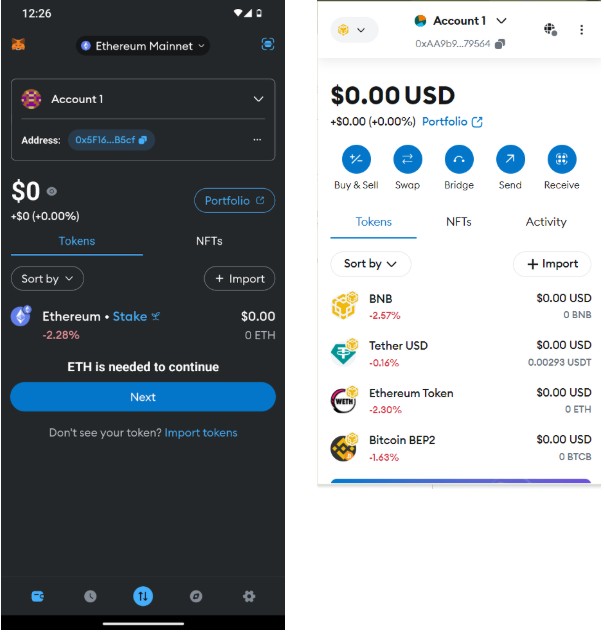
Features of Metamask
- Browser Extension & Mobile App: Metamask is available as a browser extension (Chrome, Firefox, Edge, Brave) and mobile app (iOS, Android).
- Ethereum and Ethereum Virtual Machine (EVM) Compatibility: The wallet is compatible with Ethereum and EVM-based blockchains, such as Binance Smart Chain, Polygon, and Avalanche.
- Private Key Management: Metamask gives users control of their private keys and stores them locally; not even a partial record is sent to Metamask servers.
- In-Built Swap Functionality: DeFi being a huge part of Metamask’s offering, the wallet enables in-app token swaps at real-time market rates. You can also bridge tokens in-app.
- NFT Integration: You can view and manage NFTs directly in your Metamask wallet.
- Custom Remote Call Procedure (RCP) Support: An RCP allows access to a server node on a custom network and communication with that blockchain. Users can add custom networks to their Metamask wallets.
- Web3 Integration: Metamask boasts a seamless connection to dApps, DeFi platforms, and NFT marketplaces. The app, in particular, features an inbuilt browser tailored for exploring DeFi.
User Interface
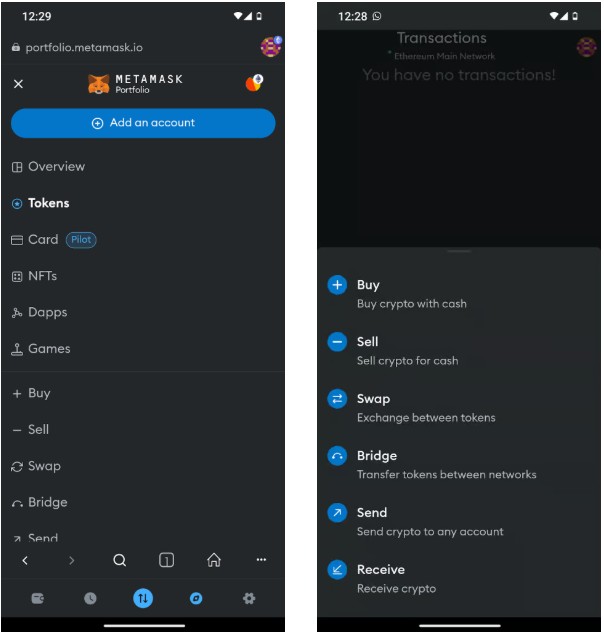
Web3 is often criticized for poor user experience (UX). However, over the years, this has become less true of Metamask. It has:
- A beginner-friendly design: Straightforward UI designed for quick navigation
- Clear wallet management: Distinct sections for tokens, NFTs, swapping, bridging, and network settings
- Customization: Using RPC to add custom tokens and networks is not as daunting as it sounds. It only takes a few minutes
Security Measures
- Password Protection: Wallet access secured with a user-created password
- Seed Phrase Backup: Recovery enabled via a 12-word seed phrase
- No Custodial Control: No third-party access to funds
- Open Source: Open-source code ensures transparency
MyEtherWallet
MyEtherWallet is a free, open-source, non-custodial cryptocurrency wallet launched in 2015 by Kosala Hemachandra. It is one of the earliest Ethereum wallets and was pivotal in popularizing Ethereum and ERC-20 tokens.
MEW was originally a web-based wallet but has since evolved to include a mobile app and browser extension for multichain and dApp interactions.
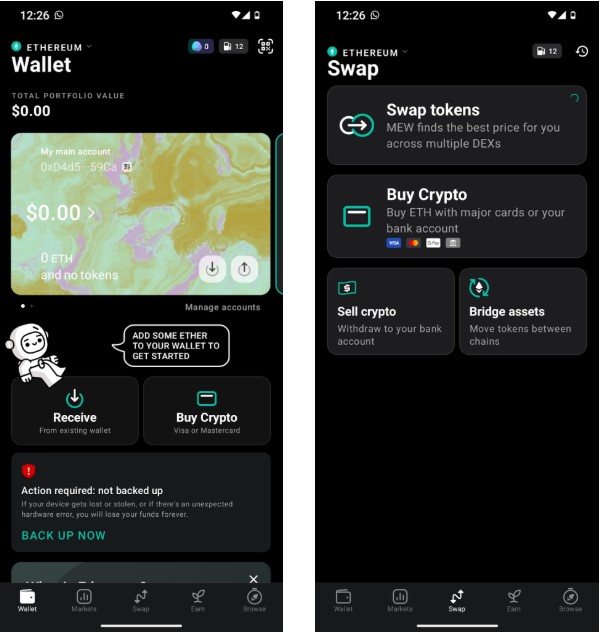
Features of MyEtherWallet
- Web-Based & Mobile App: You can access your MEW via its website or mobile app.
- Offline Wallet Creation: It enables offline wallet generation for added security. This eliminates any chance of hackers stealing your keys during wallet creation.
- Customizable Wallet Options: MEW features hardware wallet integration with Ledger and Trezor. It also supports creating and sweeping paper wallets via the app.
- Token Swapping & Staking: MEW lets users swap tokens and participate in Ethereum staking directly from the app and browser extension. On the web interface, MEW Portfolio allows users to swap over 300 different currencies across chains.
- Broad Blockchain Support: MEW offers broad access to Ethereum and its testnets, as well as other EVM-compatible chains like Binance Smart Chain, zkSync, Polygon, and others.
- Enkrypt Wallet: There is no MEW browser extension, but there is Enkrypt, a multichain browser extension by the same company.
Enkrypt Wallet
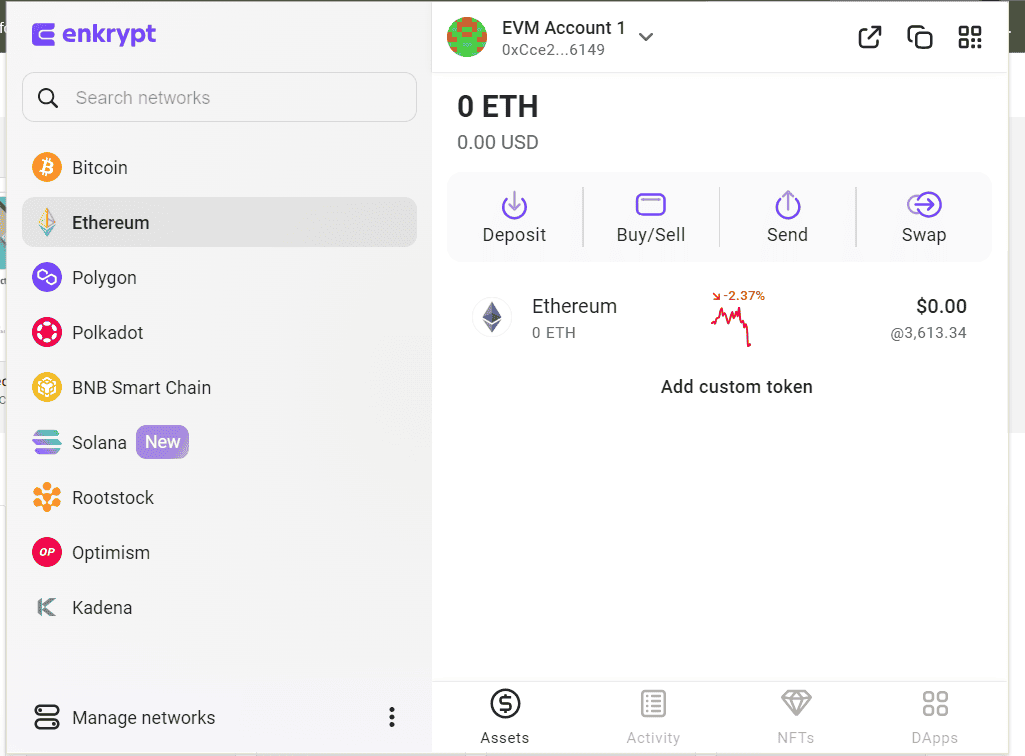
Enkrypt is a browser extension developed by MyEtherWallet (MEW) to expand its offering beyond Ethereum. It builds on MEW by providing a much broader multi-chain experience that addresses the growing demand for interoperability in Web3. It also enables interaction with dApps across supported chains.
MEW User Experience
- Advanced Features: MyEtherWallet appeals to experienced users who can fully utilize complex tools like offline transactions and paper wallet creation/sweeping.
- User interface: MEW’s UI is beautiful and well-designed. However, due to the wallets’ advanced functionality, it can feel overwhelming for newcomers.
MEW Security Protocols
For security, MEW features:
- Offline Functionality: Allows wallet creation and transaction signing offline
- Hardware Wallet Integration: Works with Trezor and Ledger devices to add security via cold storage
- Paper Wallets: Lets you create and sweep paper wallets as an alternative form of cold storage
- Open Source: Source code is publicly available for audit
Comparison
So, how do these two wallets compare:
| Metamask | MEW |
| Integration with dApps: Metamask works seamlessly with DeFi apps, NFT marketplaces, and games.There are also built-in swap and bridge functions. | Integration with dApps: MEW is well integrated with DeFi apps and protocols, though not quite at the same level as Metamask. There are also built-in tools for token staking and swapping. |
| Custom Network Support: Easily connects to blockchains beyond Ethereum, giving users access to a wide DeFi ecosystem.This allows you to manage and transact any of the over 500,000 ETH-based tokens. | Broad Cryptocurrency Support: MEW supports a wide range of EVM-compatible blockchains and tokens. The mobile app and browser interface are comparable to Metamask in this regard. Enkrypt takes it a notch higher with Bitcoin, Polkadot, and Substrate chains. |
| Learning Curve: Metamask is a relatively easy Web3 wallet to get started with. | Offline Security: MEW is ideal for cold storage solutions. |
| Phishing Risks: As with all hot wallets, users are susceptible to fake dApps and browser extensions. | Learning Curve: This can be daunting for beginners unfamiliar with cryptocurrency concepts. |
| Dependence on Users’ Security Measures: Relies heavily on users’ ability to manage seed phrase securely. | Dependence on Users’ Security Measures: Relies heavily on users’ ability to manage private keys securely. |
Which Hot Wallet Is Best for You?
Metamask and MyEtherWallet present excellent options for anyone who’s active in DeFi. If your activity is limited to Ethereum and EVM-compatible chains, Metamask would probably be a slightly better choice. But if you want to get into Polkadot, Substrate, and Bitcoin’s budding DeFi scene, then MEW’s extension (Enkrypt) gives you just that.
FAQs
Which is more secure, MEW or Metamask?
Both wallets are secure if used correctly. They give you full control of your private keys, so security depends on user practices.
Can I use both MyEtherWallet and Metamask together?
Yes, you can connect Metamask to MEW for added convenience in transactions and wallet management.
Does Metamask support more tokens than MEW?
Both support many tokens on Ethereum, BNB, Polygon, and other EVM-compatible chains. Enkrypts adds even more, including BTC and tokens on the Polkadot and Substrate ecosystems.
Can I stake Ethereum using MEW or Metamask?
Yes, both wallets support staking via third-party integrations.
